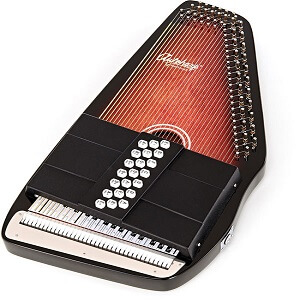Auto harp
 The autoharp is a strummed box-zither chordophone originating in Germany but also popular at one time in the United States. The first instrument pictured in the gallery was built in Dolgeville, New York, between 1892 and 1897, one of the approximately one half million autoharps produced in that span of time by the Zimmerman Autoharp Company. Most widely used for song accompaniment in the home and in regional styles of vernacular American music, the autoharp is sometimes also played in old-time string bands for dance accompaniment. Interest in the instrument today in the United States is facilitated through enthusiast newsletters and a circuit of workshops, competitions, and festivals. The first audio clip illustrates the use of the autoharp in Anglo-American folk music. In the mid-20th century, models of the autoharp like the one pictured in the second gallery photo were used in American public school music programs to teach the rudiments of harmony, and in the last half of the 20th century such instruments have been used sparingly in styles as varied as folk-rock, flamenco, Celtic, and New Age. Like many instruments, the autoharp has traveled far and wide in the hands of sailors, soldiers, missionaries and settlers, and in the process it has been introduced to musicians in other cultures who in turn have adapted the instrument to their own needs. The second audio clip, recorded in 1950s South Africa, illustrates one such adaptation in which the performer plucks rather than strums the strings of the autoharp.
The autoharp is a strummed box-zither chordophone originating in Germany but also popular at one time in the United States. The first instrument pictured in the gallery was built in Dolgeville, New York, between 1892 and 1897, one of the approximately one half million autoharps produced in that span of time by the Zimmerman Autoharp Company. Most widely used for song accompaniment in the home and in regional styles of vernacular American music, the autoharp is sometimes also played in old-time string bands for dance accompaniment. Interest in the instrument today in the United States is facilitated through enthusiast newsletters and a circuit of workshops, competitions, and festivals. The first audio clip illustrates the use of the autoharp in Anglo-American folk music. In the mid-20th century, models of the autoharp like the one pictured in the second gallery photo were used in American public school music programs to teach the rudiments of harmony, and in the last half of the 20th century such instruments have been used sparingly in styles as varied as folk-rock, flamenco, Celtic, and New Age. Like many instruments, the autoharp has traveled far and wide in the hands of sailors, soldiers, missionaries and settlers, and in the process it has been introduced to musicians in other cultures who in turn have adapted the instrument to their own needs. The second audio clip, recorded in 1950s South Africa, illustrates one such adaptation in which the performer plucks rather than strums the strings of the autoharp.
The autoharp consists of a shallow five-sided trapezoidal-shaped box resonator constructed of wood. Solid planks of wood are joined together to form the frame with the pieces that end up serving as the pinblock needing to be particularly robust. Thin boards of softwood are used for the soundboard and back, and the former has a soundhole cut in it beneath the damper bars. Internal struts run between the soundboard and backboard from side-to-side to strengthen the structure. Twenty-three single course wire strings of varying gauges are held in tension in a plain parallel to the soundboard. They are kept just above the soundboard by a long ridge-nut, located along the bottom edge of the soundboard, and a long pressure bridge, situated just inside the row of tuning pins at the top end and along the slanted side of the soundboard; both the bridge and the nut are capped with a wire saddle. Each string has a noose at one end that is looped around a metal hitch pin nailed into the resonator side at the bottom end of the instrument. Each string then makes contact with the lower nut, runs the length of the soundboard until it contacts the upper nut, and then is threaded through and wound around a tuning pin. A T-shaped tool is used to turn these pins to tune the strings. The damper bars are located above the plain of strings and perpendicular to them. They are made of narrow lengths of wood with thick felt glued to their bottom side and are housed in a separate structure built up from the resonator frame. This structure consists of two end-walls attached to the resonator frame each housing a row of five springs, each spring supporting the end of a damper bar. The felt dampers on any given bar are shaped so that when a bar is depressed by pressing down on its white button it silences all the strings except those tuned to the pitches in the desired chord. The second autoharp in the gallery differs structurally from the one just described in a number of ways: it is larger; it has thirty-six single course strings of varying gauges; and it has fifteen damper bars with rubber rather than felt dampers.